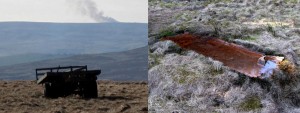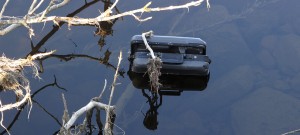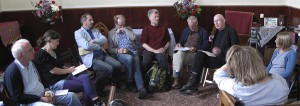Friend’s work – links and texts
As ‘herd animals’ we live and die in constant conversation with all those ‘others’ – whether actual or spectral – who are, broadly speaking and for better or worse, our friends.
In this section I try to acknowledge this connectivity by listed examples of particular works by people that I admire, giving web sites, published texts, etc. for projects that I consider to be important or simply valuable to me.
Samira Abbassy – Samira is an Arab-Iranian born in the city of Ahwaz in southwestern Iran. In 1967, her family moved to Britain where she was educated and studied painting. She currently lives in the USA .Her “the Eternal War” series examines mythologies around “Holy Wars” and draws on ideas around the Cult of Martyrdom in Shia Islam.
Christine Baeumler – Christine’s Reconstituting the Landscape: A Tamarack Rooftop Restoration, involving collaboration between an eco-artist, engineer, ecologist, and institution regarding a specific and threatened bog ecology in the State of Minnesota.
Luci Gorell Barnes is an artist / social activist working in Bristol. Her Atlas of Human Kindness is a wonderful example of how the cartographic impulse can be re-oriented
Jessica de Boer – Jessica, who is based in Groningen in the north of the Netherlands and works along the boundaries between art and science, shares my interest in contemporary animism. An artist, curator and researcher, she initiated and co-curated the cultural program Zsunday: a platform for unprecedented research and ‘collisions’ between artists, scientist and musicians. In 2011 she investigated animism in Mexico by engaging with Huichol Indians, resulting in “The Life of the Dead Blue Hummingbird” and a publication on contemporary animism in 2012. She is currently undertaking PhD research in Spatial Planning at the University of Groningen.
Natalie Boulton – Originally trained as a painter, and now a full-time carer for our daughter, Natalie works (unpaid) as a patient advocate, editor, designer, and directed the film Voices From The Shadows (in addition to all this she is also my wife)! See also http://www.mcs-international.org/news_lost_voices.html
Jethro Brice is an environmental artist based in Bristol with whom I’ve various links, including a shared connection to researchers at the University of Groningen.
Marlene Creates – Marlene’s Sleeping Places, Newfoundland 1982 has haunted me ever since I heard her speak about it at a LAND2 gathering. It seems to me to be both related to, and the antithesis of, Richard Long’s work.
Ronnie Close – Roni’s Ultras, which examines individual members of the Ultras, the non-sectarian and classless inner membership the Cairo based football team Al-Ahly (The Nation). The Ultras, formed in 2007, supported the revolution to oust Hosni Mubarak and are committed to fighting for democracy. See also Liam Devlin ‘Interview with Ronnie Close’ in Photoworks Magazine, Issue 19, Oct 2012, pp 46-51
Eamon Colman – Eamon is a painter deeply committed to both to the art of painting and its ability to extend our sense of land. He lives with his partner, Pauline O’Connell, and their son in the uplands of County Kilkenny in Ireland. Although he’s usually called a landscape painter, he’d described himself as “fundamentally … a storyteller”, as influenced by “listening to other people’s stories and interpreting their dreams”.
Katie Davies – Katie’s The Separation Line, which responds to British repatriation ceremonies in the small English market town of Wootton Bassett and aims to reveal an experience of the British border shared by hundreds of civilians and members of the British Armed Forces. See also Davies, K (2013) ‘Border imaging: revealing the gaps between the reality, the representation and the experience of the border’ in Border Visions Identity and Diaspora in Film Maryland: Scarecrow Press.
Cathy Fitzgerald – Cathy’s slow art, experimental forest transformation project The Hollywood Diaries (2008 – ongoing), is centered in a small conifer plantation where she lives in rural Ireland. It involves engagement with forest tending, experimental films, writings and social media, and new and emergent understandings of ‘deep sustainability’. See her ‘The Artful Inquiry’ in Peter Reason and Melanie Newman (eds) (2013) ‘Stories of the Great Turning’, introduced by Joanna Macy, Bristol: Vala Publishers Coop; and: Karen Till (2012) ‘Field Findings’ in The Red Stables Art & Ecology Summer School, Dublin City Council Arts Office, Ireland. Dec. 2012. pp. 25-6.
Alexandra Handal – Alexandra’s Dream Homes property consultants, is a website where stories of dispossession, displacement and cultural cleansing unfold in the setting of a real estate agency. It is built entirely from oral history research with Palestinian refugees from West Jerusalem. See also Alexandra Handal (2013) ‘Chronicle From The Field’ in Sandino, L & Partington, M (eds) Oral History in the Visual Arts London: Bloomsbury.
Jennifer Heath of baksun books and arts for social and environmental justice, 1838 Pine Street, Boulder, Colorado 80302 USA. I came into contact with Jennifer through Nessa Cronin, who wrote a chapter for the book that is part of Jennifer’s The Map is not the Territory project (see my blog post for 18/06/2015). There are a number of fascinating sites related to Jennifer’s work, including: The Lore of the Garden and Water, Water Everywhere, a new-media exhibition that collects and posts poetry, prose and artwork about water issues.
Angelo Jonas Imperiale is a PhD Researcher at the Department of Cultural Geography,
Faculty of Spatial Sciences, at the University of Groningen. He is engaged with Viva La Reparacion, which is working to create a “rural living room” in L’Aquila, so as to build a living dialogue between the city and its rural and mountain landscape. This work grows out of the fact that L’Aquila was devastated by an earthquake on April 6, 2009.
Ffion Jones – is a doctoral student at Aberystwyth University. Her project is summarised at: http://www.aber.ac.uk/en/tfts/study-with-us/phd/phd-students/ffion-jones/ An edited version of the film used in her performance, Dear Mike Jagger (the reference is to an orphaned lamb with a jagger-like strut) can now be found online.
Ruth Jones – Ruth works as an artist, curator and organizer in relation to Holy Hiatus, a small organisation dedicated to exploring the contemporary intersection of society, art and ritual.
Rebecca Krinke – Rebecca is a polymath – sculptor, landscape architect, teacher and maker of participatory work like her Seen/Unseen: The Mapping of Joy and Pain, a project that’s been through a number of versions in different places and remains a vital point of reference for me in terms of a certain kind of participatory work.
Rona Lee – Rona’s That Oceanic Feeling, which investigates our relationship to the deep sea (the most inaccessible location on the planet), developed whilst working at the National Oceanography Centre, Southampton alongside geoscientists who use sonar to map the deepest and darkest parts of the earth and Lee, R (2013) ‘Envisaging the Deep – imagining a relational geography of the uninhabitable’ in Emerging Landscapes – Between Production and Representation London: Ashgate (forthcoming).
Gini Lee – Gini’s Deep Mapping for the Stony Rises, which assembles topographies and topologies encountered while making a cross-landscape environment for six particular places in the Stony Rises of Victoria and the Flinders Ranges of South Australia.
Joyce Lyon – Joyce’s Conversations with Rzeszow is a sustained meditation on place. It engages in a dialogue with Rzeszow, a small city in southeastern Poland where her father grew up within an extensive Jewish community destroyed in World War II. Some of the drawings relate to places in Poland: to Birkenau and woods near Rzeszow; others to a Minneapolis bird sanctuary and a family summer home in New York. For Joyce the metaphor and construct of place becomes a way to explore “many kinds of knowing: one’s own direct experience and its limitations, what can be intuited, what it is possible to learn at a distance, and what cannot, finally, be understood”.
Mary Modeen – Mary is a dear friend and, although technically The Enigma of Place is a collaborative multi-media installation made by us both, it is really her piece, with some material of mine added. (I was too ill to contribute to the installation). She made it for Sensory Worlds: Environment, Value and the Multi-Sensory 7-9th December, 2011, in conjunction with the conference of the Sawyer Seminar Series Embodied Values: Bringing the Senses Back to the Environment at the Institute for Advanced Studies in the Humanities (IASH), University of Edinburgh.
Pauline O’Connell – Pauline’s two-part project Heave-Ho, An Invitation To Community and Heave-Ho, Pub Pulling League, based on the game Tug O’ War, which explores and evokes issues of community, and O’Connell, P. (2012) “Hypomnemata, A Memory Trace”, Cassagh Press ISBN 978-0-9547955-2-8
Deirdre O’Mahony works regionally, nationally and internationally as an artist, teaches at the Centre for Creative Arts and Media at the Galway-Mayo Institute, and is involved as a researcher, eco-social activist and, on a number of levels, an active enabler and observant participant in Killinaboy, Co. Clare, where she initiated the X-PO project.
Rowan O’Neill – Rowan is an artist from Felinwynt in West Wales whose work is informed by her academic background in theology and religious studies and the contrast between British urban society and her Welsh agricultural upbringing. Her chief interest lies in the role of performance as a channel for transfigurative experience. She has recently completed a doctoral study of the work of Cliff McLucas – ‘Contemporary Welsh Theatre in the twentieth century: Cliff McLucas and the performance space’.
Perdita Phillips – Perdita’s The Sixth Shore, which applies ecosystemic thinking to a specific locale through walking and listening to country, part of the wider project Adaption set up and run by SymbioticA, an artistic laboratory at the University of Western Australia. See also Phillips, P. (2010) Clotted Life and Brittle Waters. Landscapes, 3(2).
Kyra Pollitt – On her web site Kyra describes herself as an artist and professional translator, but this isn’t the half of it. While it’s true that she is bi-lingual in English and British Sign Language, and has practised as an interpreter and translator with this language combination for over 20 years, there is a great deal more to her than this might suggest. As Nanafroufrou she is an authority on the poetics of natural sign languages, has her own practice in theatre and performance interpreting, and is actively engaged in the creative practices of ‘translation art’ and ‘[w]righting’.
Bronwyn Platten – Bronwyn’s Mouths and Meaning – a research project, exhibition, and book – which explores and represents experiences of embodiment for people who have been affected by the experience of an eating disorder and reflects her intensive involvement in the field of arts in healthcare. See also Platten, B & Gibson, B (2012) Mouths and Meaning: Workshop 1, Manchester: The University of Salford & Leftfield Creative.
Simon Read – Simon’s environmentally oriented work is a constant source of inspiration. He and I were students together and have followed a strangely parallel route in our professional life – in a recent film about visualising environmental change he appears with Stephen Daniels, Caitlin DeSilvey, and Mike Pearson, all of whom I’ve also worked with.
Sarah Rhys – Sarah and I have worked together on a couple of projects that relate to my PLaCE work and I’m particularly interested in the way she is exploring the ‘placing’ of various elements of her Welsh heritage.
Shawn Sobers – Shawn’s Custodians, which explores the motivations of contemporary custodians of narratives relating to the lives of African and Asian people who lived in the UK in the 17th, 18th and 19th centuries, and the importance of particular places, sites, locations and structures to them.
Veronica Vickery – Veronica’s Poniou, a long-term site-based enquiry concerning a small west Cornish stream which uses an augmented installation of paintings to reflect on current geographical understandings of place through the medium of aesthetic process.
Stephanie Wong – Stephanie is an artist with a first degree in neuroscience currently studying on the MA Arts and Science at Central St.Martins in London. She is also on the staff as Project Assistant with Invisible Dust, an organisation that works with leading artists and scientists to produce unique and exciting works of contemporary art and new scientific ideas exploring our environment and climate change.


